BSBWOR404 Diploma of Nursing: Work Priorities, Planning and Schedule
VerifiedAdded on 2023/06/15
|10
|1878
|127
Homework Assignment
AI Summary
This assignment focuses on developing work priorities within a nursing context (BSBWOR404). It addresses factors affecting work objectives, including the work environment, staffing schedules, rewards, and skills. Contingency plans are outlined to mitigate these factors, alongside the use of business technology for managing schedules and patient care. The assignment emphasizes self-assessment using Gibb’s reflective cycle and clinical nurse appraisal tools, and it includes a hand hygiene survey to address nosocomial infections. Professional development activities, task scheduling using Gantt charts, and personal planning through SWOT analysis and SMART goals are also discussed. Finally, the document explores methods for eliciting, analyzing, and interpreting feedback to improve performance. Desklib provides a platform for students to access similar solved assignments and past papers.
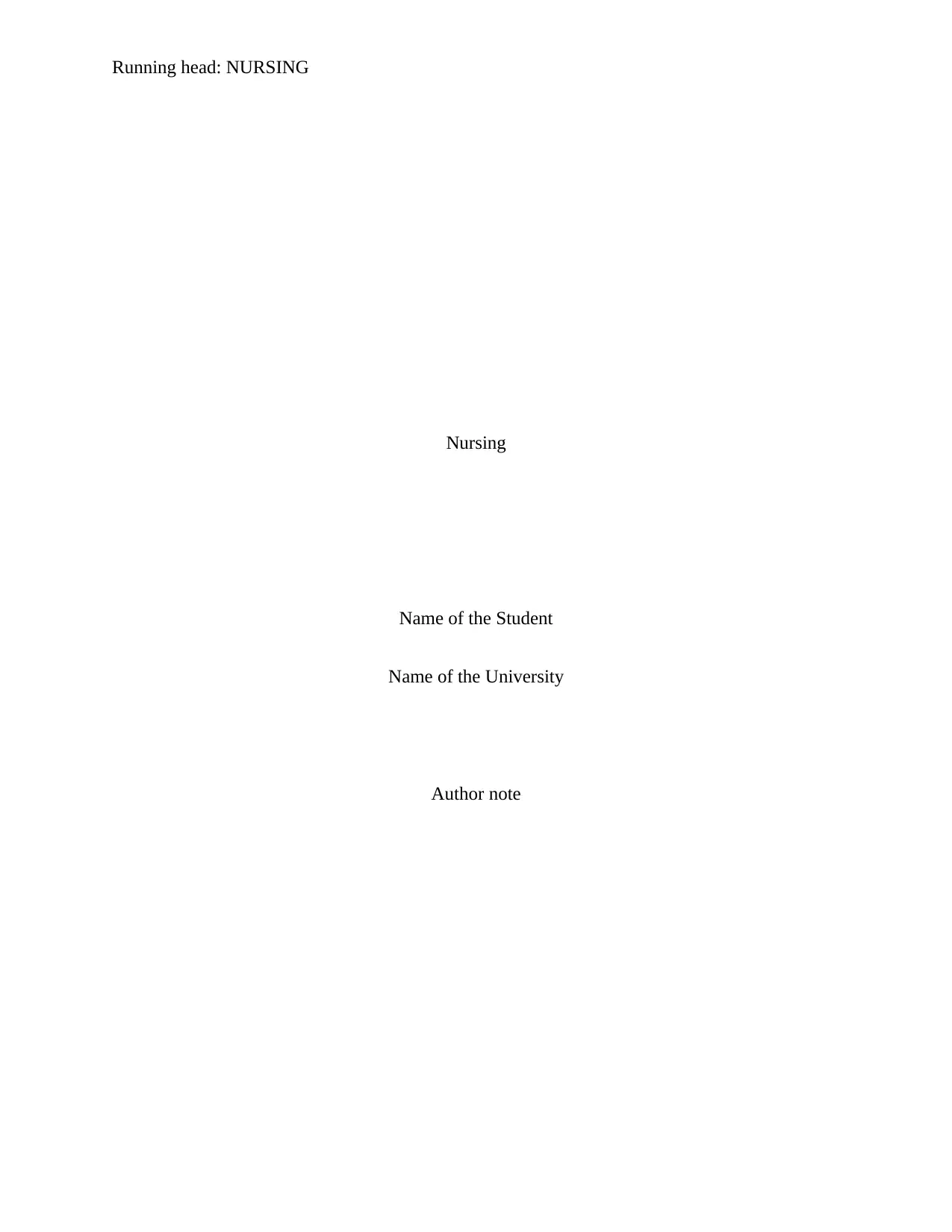
Running head: NURSING
Nursing
Name of the Student
Name of the University
Author note
Nursing
Name of the Student
Name of the University
Author note
Paraphrase This Document
Need a fresh take? Get an instant paraphrase of this document with our AI Paraphraser
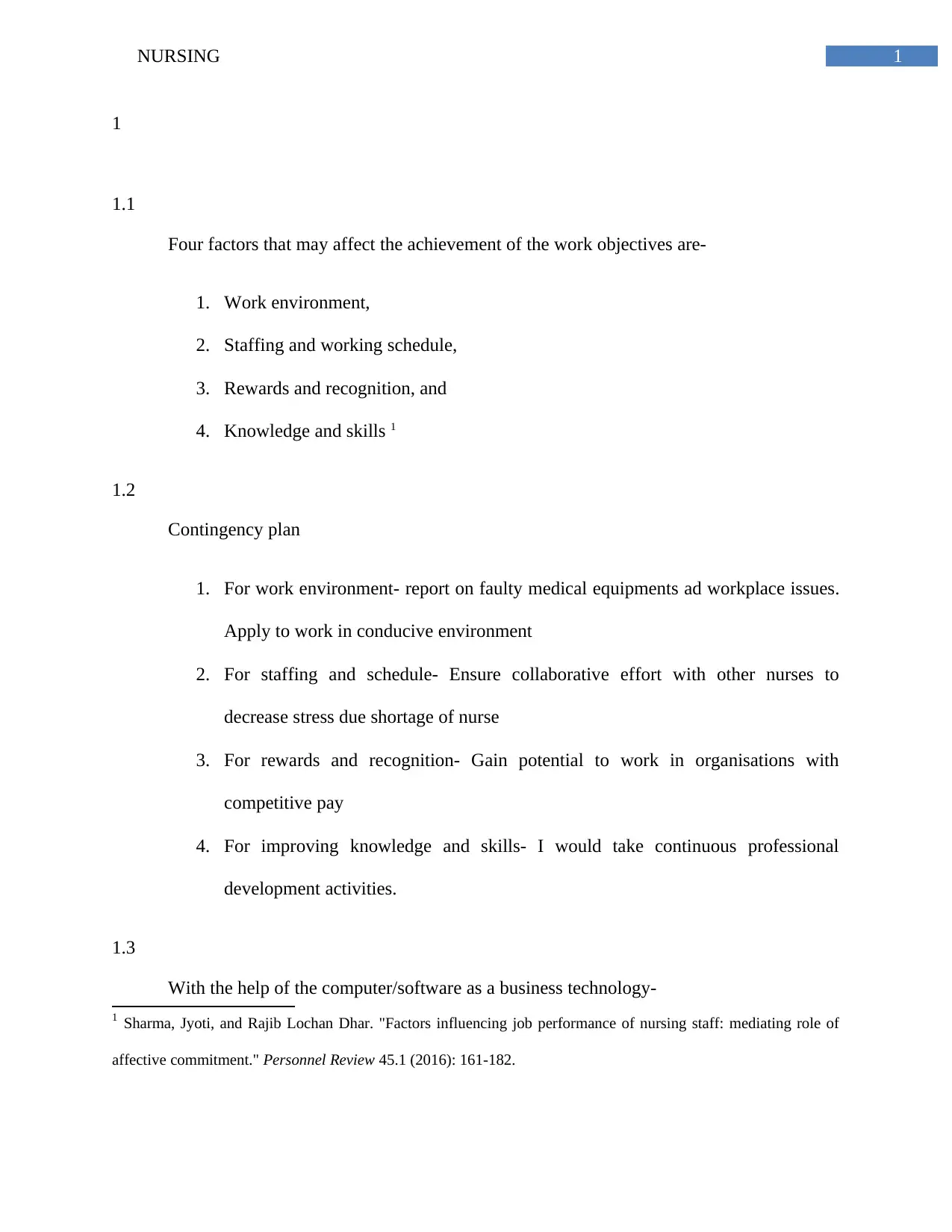
1NURSING
1
1.1
Four factors that may affect the achievement of the work objectives are-
1. Work environment,
2. Staffing and working schedule,
3. Rewards and recognition, and
4. Knowledge and skills 1
1.2
Contingency plan
1. For work environment- report on faulty medical equipments ad workplace issues.
Apply to work in conducive environment
2. For staffing and schedule- Ensure collaborative effort with other nurses to
decrease stress due shortage of nurse
3. For rewards and recognition- Gain potential to work in organisations with
competitive pay
4. For improving knowledge and skills- I would take continuous professional
development activities.
1.3
With the help of the computer/software as a business technology-
1 Sharma, Jyoti, and Rajib Lochan Dhar. "Factors influencing job performance of nursing staff: mediating role of
affective commitment." Personnel Review 45.1 (2016): 161-182.
1
1.1
Four factors that may affect the achievement of the work objectives are-
1. Work environment,
2. Staffing and working schedule,
3. Rewards and recognition, and
4. Knowledge and skills 1
1.2
Contingency plan
1. For work environment- report on faulty medical equipments ad workplace issues.
Apply to work in conducive environment
2. For staffing and schedule- Ensure collaborative effort with other nurses to
decrease stress due shortage of nurse
3. For rewards and recognition- Gain potential to work in organisations with
competitive pay
4. For improving knowledge and skills- I would take continuous professional
development activities.
1.3
With the help of the computer/software as a business technology-
1 Sharma, Jyoti, and Rajib Lochan Dhar. "Factors influencing job performance of nursing staff: mediating role of
affective commitment." Personnel Review 45.1 (2016): 161-182.
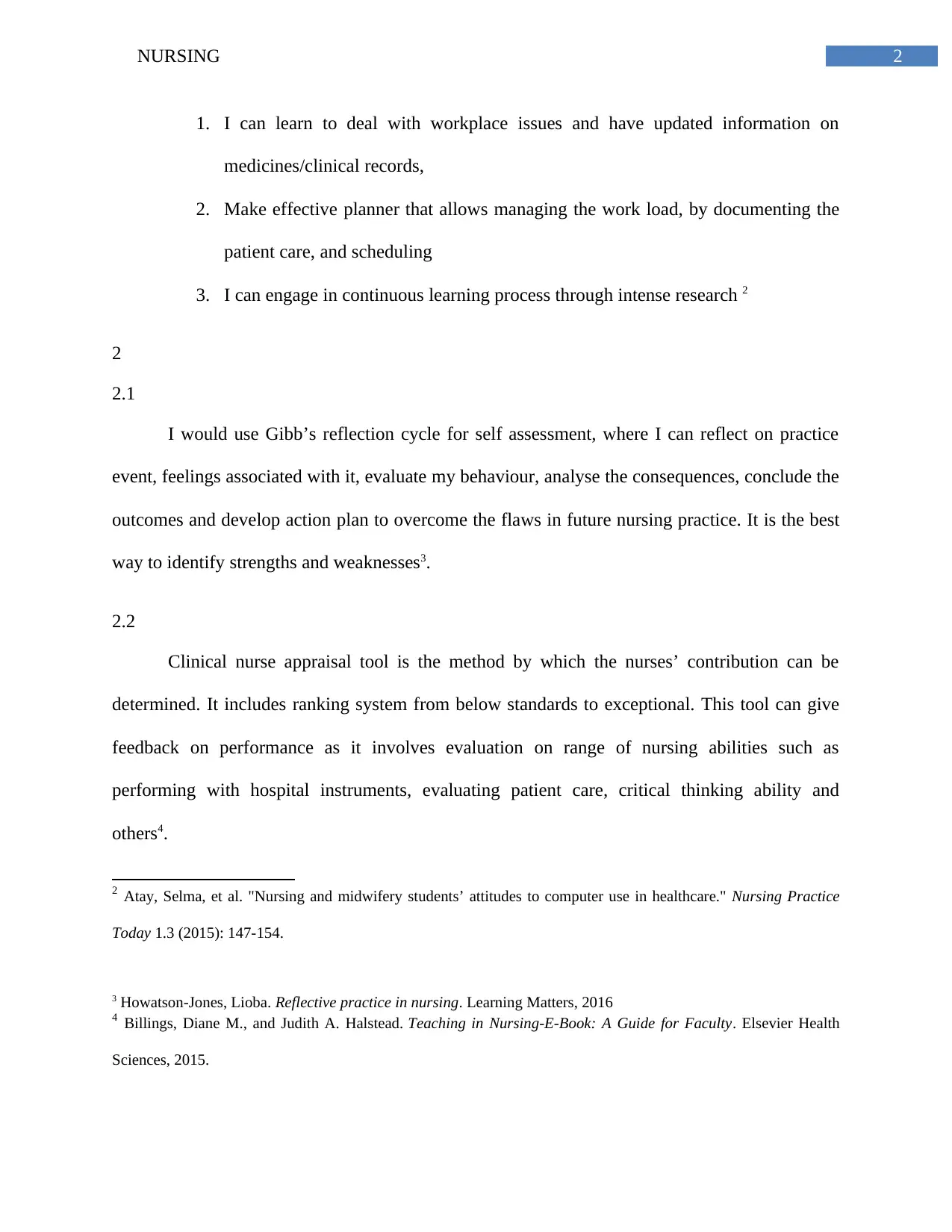
2NURSING
1. I can learn to deal with workplace issues and have updated information on
medicines/clinical records,
2. Make effective planner that allows managing the work load, by documenting the
patient care, and scheduling
3. I can engage in continuous learning process through intense research 2
2
2.1
I would use Gibb’s reflection cycle for self assessment, where I can reflect on practice
event, feelings associated with it, evaluate my behaviour, analyse the consequences, conclude the
outcomes and develop action plan to overcome the flaws in future nursing practice. It is the best
way to identify strengths and weaknesses3.
2.2
Clinical nurse appraisal tool is the method by which the nurses’ contribution can be
determined. It includes ranking system from below standards to exceptional. This tool can give
feedback on performance as it involves evaluation on range of nursing abilities such as
performing with hospital instruments, evaluating patient care, critical thinking ability and
others4.
2 Atay, Selma, et al. "Nursing and midwifery students’ attitudes to computer use in healthcare." Nursing Practice
Today 1.3 (2015): 147-154.
3 Howatson-Jones, Lioba. Reflective practice in nursing. Learning Matters, 2016
4 Billings, Diane M., and Judith A. Halstead. Teaching in Nursing-E-Book: A Guide for Faculty. Elsevier Health
Sciences, 2015.
1. I can learn to deal with workplace issues and have updated information on
medicines/clinical records,
2. Make effective planner that allows managing the work load, by documenting the
patient care, and scheduling
3. I can engage in continuous learning process through intense research 2
2
2.1
I would use Gibb’s reflection cycle for self assessment, where I can reflect on practice
event, feelings associated with it, evaluate my behaviour, analyse the consequences, conclude the
outcomes and develop action plan to overcome the flaws in future nursing practice. It is the best
way to identify strengths and weaknesses3.
2.2
Clinical nurse appraisal tool is the method by which the nurses’ contribution can be
determined. It includes ranking system from below standards to exceptional. This tool can give
feedback on performance as it involves evaluation on range of nursing abilities such as
performing with hospital instruments, evaluating patient care, critical thinking ability and
others4.
2 Atay, Selma, et al. "Nursing and midwifery students’ attitudes to computer use in healthcare." Nursing Practice
Today 1.3 (2015): 147-154.
3 Howatson-Jones, Lioba. Reflective practice in nursing. Learning Matters, 2016
4 Billings, Diane M., and Judith A. Halstead. Teaching in Nursing-E-Book: A Guide for Faculty. Elsevier Health
Sciences, 2015.
⊘ This is a preview!⊘
Do you want full access?
Subscribe today to unlock all pages.

Trusted by 1+ million students worldwide
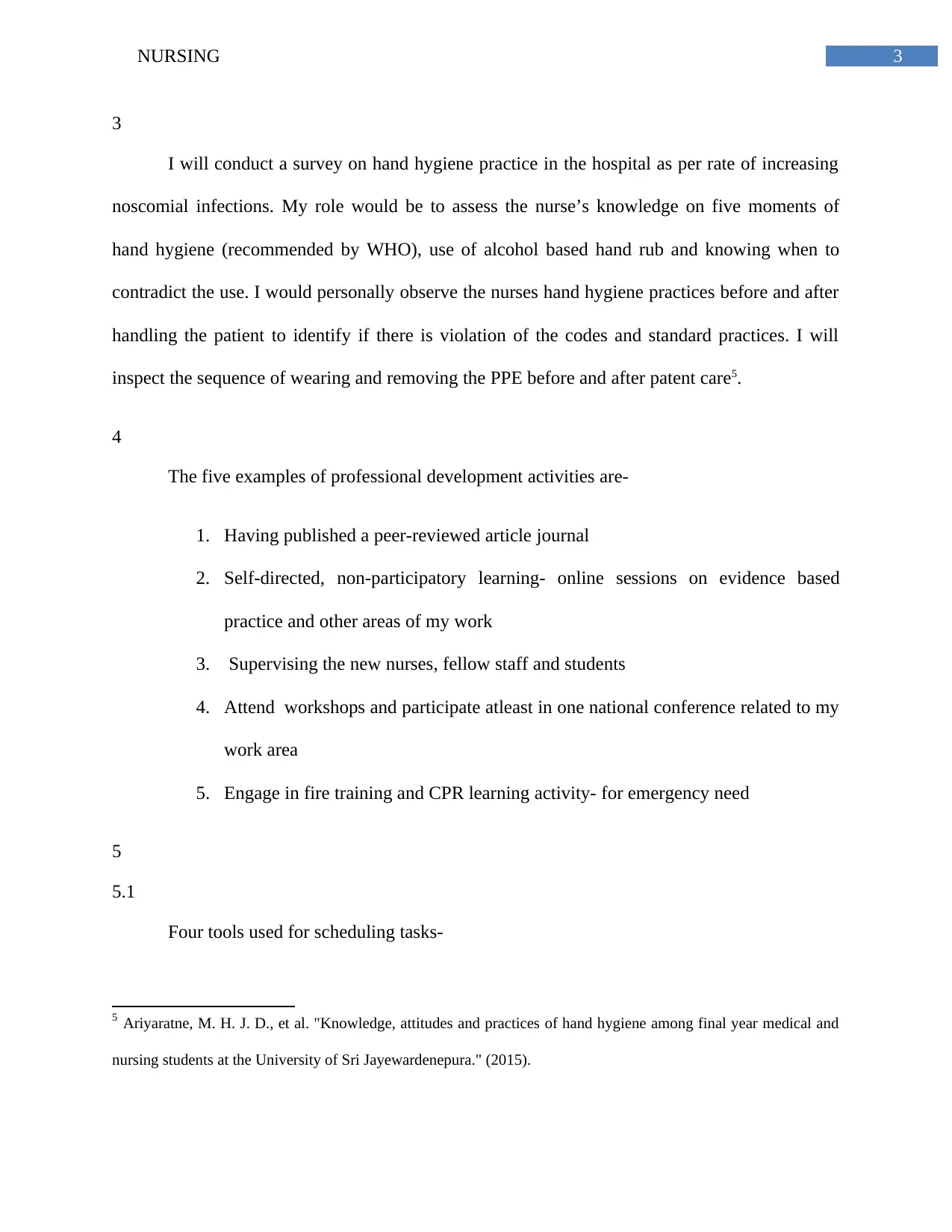
3NURSING
3
I will conduct a survey on hand hygiene practice in the hospital as per rate of increasing
noscomial infections. My role would be to assess the nurse’s knowledge on five moments of
hand hygiene (recommended by WHO), use of alcohol based hand rub and knowing when to
contradict the use. I would personally observe the nurses hand hygiene practices before and after
handling the patient to identify if there is violation of the codes and standard practices. I will
inspect the sequence of wearing and removing the PPE before and after patent care5.
4
The five examples of professional development activities are-
1. Having published a peer-reviewed article journal
2. Self-directed, non-participatory learning- online sessions on evidence based
practice and other areas of my work
3. Supervising the new nurses, fellow staff and students
4. Attend workshops and participate atleast in one national conference related to my
work area
5. Engage in fire training and CPR learning activity- for emergency need
5
5.1
Four tools used for scheduling tasks-
5 Ariyaratne, M. H. J. D., et al. "Knowledge, attitudes and practices of hand hygiene among final year medical and
nursing students at the University of Sri Jayewardenepura." (2015).
3
I will conduct a survey on hand hygiene practice in the hospital as per rate of increasing
noscomial infections. My role would be to assess the nurse’s knowledge on five moments of
hand hygiene (recommended by WHO), use of alcohol based hand rub and knowing when to
contradict the use. I would personally observe the nurses hand hygiene practices before and after
handling the patient to identify if there is violation of the codes and standard practices. I will
inspect the sequence of wearing and removing the PPE before and after patent care5.
4
The five examples of professional development activities are-
1. Having published a peer-reviewed article journal
2. Self-directed, non-participatory learning- online sessions on evidence based
practice and other areas of my work
3. Supervising the new nurses, fellow staff and students
4. Attend workshops and participate atleast in one national conference related to my
work area
5. Engage in fire training and CPR learning activity- for emergency need
5
5.1
Four tools used for scheduling tasks-
5 Ariyaratne, M. H. J. D., et al. "Knowledge, attitudes and practices of hand hygiene among final year medical and
nursing students at the University of Sri Jayewardenepura." (2015).
Paraphrase This Document
Need a fresh take? Get an instant paraphrase of this document with our AI Paraphraser
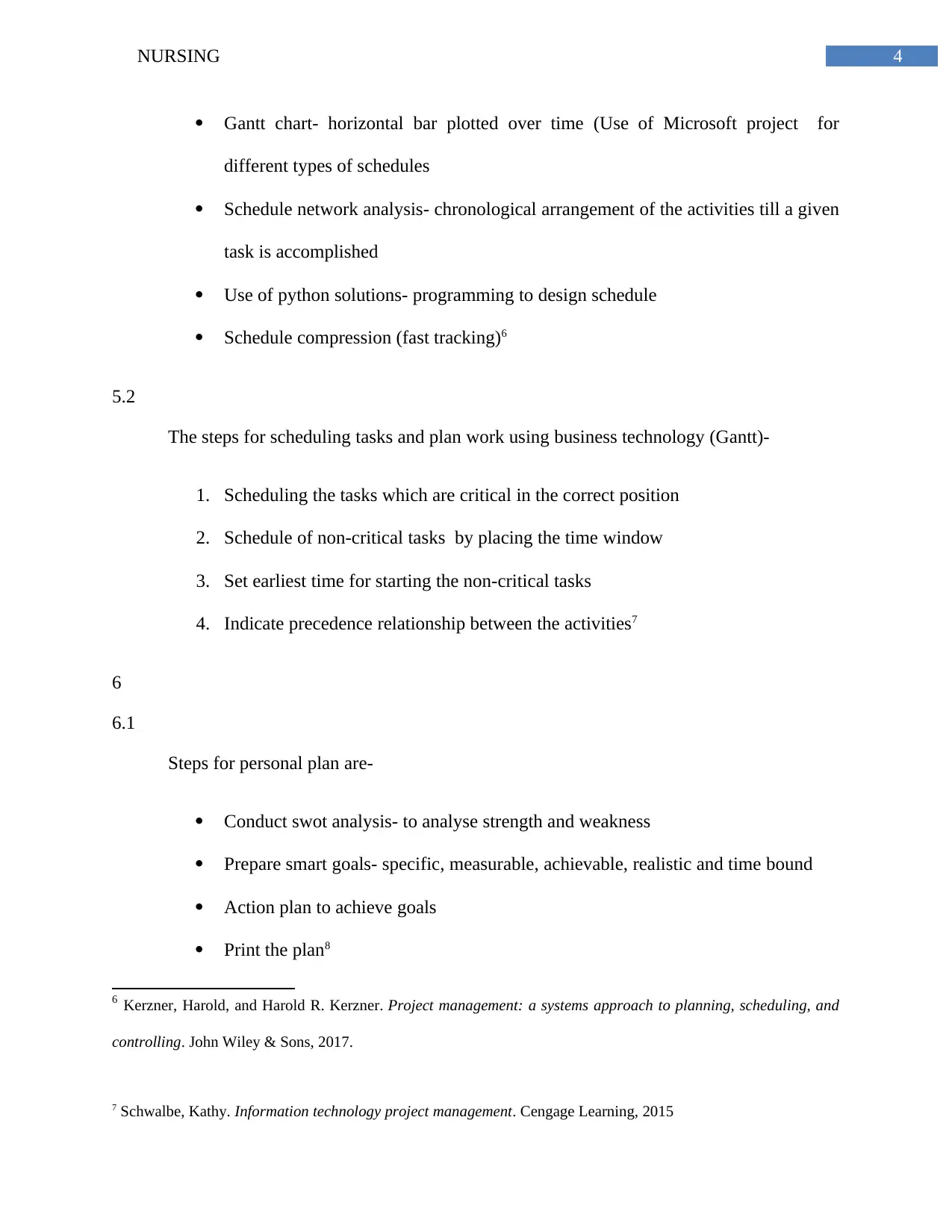
4NURSING
Gantt chart- horizontal bar plotted over time (Use of Microsoft project for
different types of schedules
Schedule network analysis- chronological arrangement of the activities till a given
task is accomplished
Use of python solutions- programming to design schedule
Schedule compression (fast tracking)6
5.2
The steps for scheduling tasks and plan work using business technology (Gantt)-
1. Scheduling the tasks which are critical in the correct position
2. Schedule of non-critical tasks by placing the time window
3. Set earliest time for starting the non-critical tasks
4. Indicate precedence relationship between the activities7
6
6.1
Steps for personal plan are-
Conduct swot analysis- to analyse strength and weakness
Prepare smart goals- specific, measurable, achievable, realistic and time bound
Action plan to achieve goals
Print the plan8
6 Kerzner, Harold, and Harold R. Kerzner. Project management: a systems approach to planning, scheduling, and
controlling. John Wiley & Sons, 2017.
7 Schwalbe, Kathy. Information technology project management. Cengage Learning, 2015
Gantt chart- horizontal bar plotted over time (Use of Microsoft project for
different types of schedules
Schedule network analysis- chronological arrangement of the activities till a given
task is accomplished
Use of python solutions- programming to design schedule
Schedule compression (fast tracking)6
5.2
The steps for scheduling tasks and plan work using business technology (Gantt)-
1. Scheduling the tasks which are critical in the correct position
2. Schedule of non-critical tasks by placing the time window
3. Set earliest time for starting the non-critical tasks
4. Indicate precedence relationship between the activities7
6
6.1
Steps for personal plan are-
Conduct swot analysis- to analyse strength and weakness
Prepare smart goals- specific, measurable, achievable, realistic and time bound
Action plan to achieve goals
Print the plan8
6 Kerzner, Harold, and Harold R. Kerzner. Project management: a systems approach to planning, scheduling, and
controlling. John Wiley & Sons, 2017.
7 Schwalbe, Kathy. Information technology project management. Cengage Learning, 2015
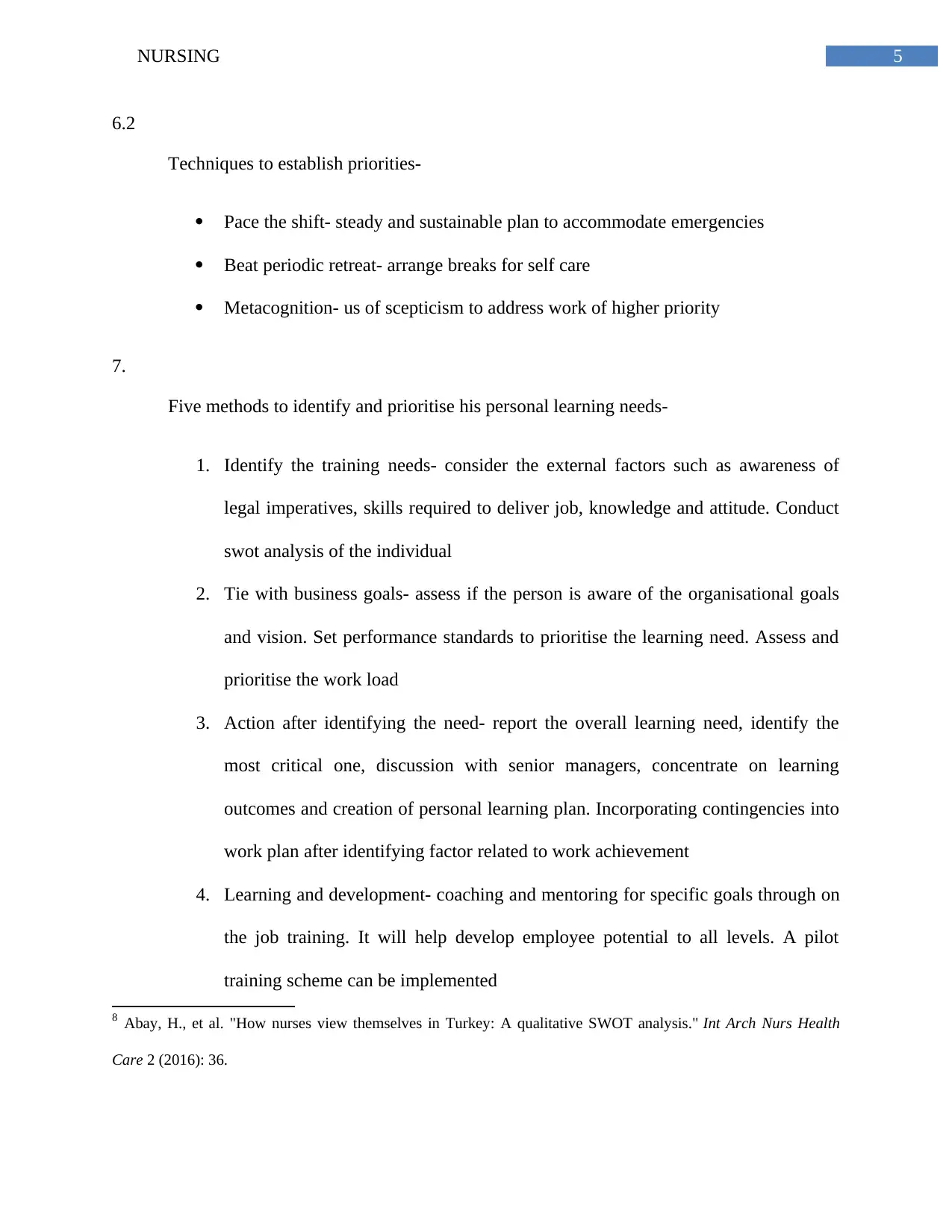
5NURSING
6.2
Techniques to establish priorities-
Pace the shift- steady and sustainable plan to accommodate emergencies
Beat periodic retreat- arrange breaks for self care
Metacognition- us of scepticism to address work of higher priority
7.
Five methods to identify and prioritise his personal learning needs-
1. Identify the training needs- consider the external factors such as awareness of
legal imperatives, skills required to deliver job, knowledge and attitude. Conduct
swot analysis of the individual
2. Tie with business goals- assess if the person is aware of the organisational goals
and vision. Set performance standards to prioritise the learning need. Assess and
prioritise the work load
3. Action after identifying the need- report the overall learning need, identify the
most critical one, discussion with senior managers, concentrate on learning
outcomes and creation of personal learning plan. Incorporating contingencies into
work plan after identifying factor related to work achievement
4. Learning and development- coaching and mentoring for specific goals through on
the job training. It will help develop employee potential to all levels. A pilot
training scheme can be implemented
8 Abay, H., et al. "How nurses view themselves in Turkey: A qualitative SWOT analysis." Int Arch Nurs Health
Care 2 (2016): 36.
6.2
Techniques to establish priorities-
Pace the shift- steady and sustainable plan to accommodate emergencies
Beat periodic retreat- arrange breaks for self care
Metacognition- us of scepticism to address work of higher priority
7.
Five methods to identify and prioritise his personal learning needs-
1. Identify the training needs- consider the external factors such as awareness of
legal imperatives, skills required to deliver job, knowledge and attitude. Conduct
swot analysis of the individual
2. Tie with business goals- assess if the person is aware of the organisational goals
and vision. Set performance standards to prioritise the learning need. Assess and
prioritise the work load
3. Action after identifying the need- report the overall learning need, identify the
most critical one, discussion with senior managers, concentrate on learning
outcomes and creation of personal learning plan. Incorporating contingencies into
work plan after identifying factor related to work achievement
4. Learning and development- coaching and mentoring for specific goals through on
the job training. It will help develop employee potential to all levels. A pilot
training scheme can be implemented
8 Abay, H., et al. "How nurses view themselves in Turkey: A qualitative SWOT analysis." Int Arch Nurs Health
Care 2 (2016): 36.
⊘ This is a preview!⊘
Do you want full access?
Subscribe today to unlock all pages.

Trusted by 1+ million students worldwide
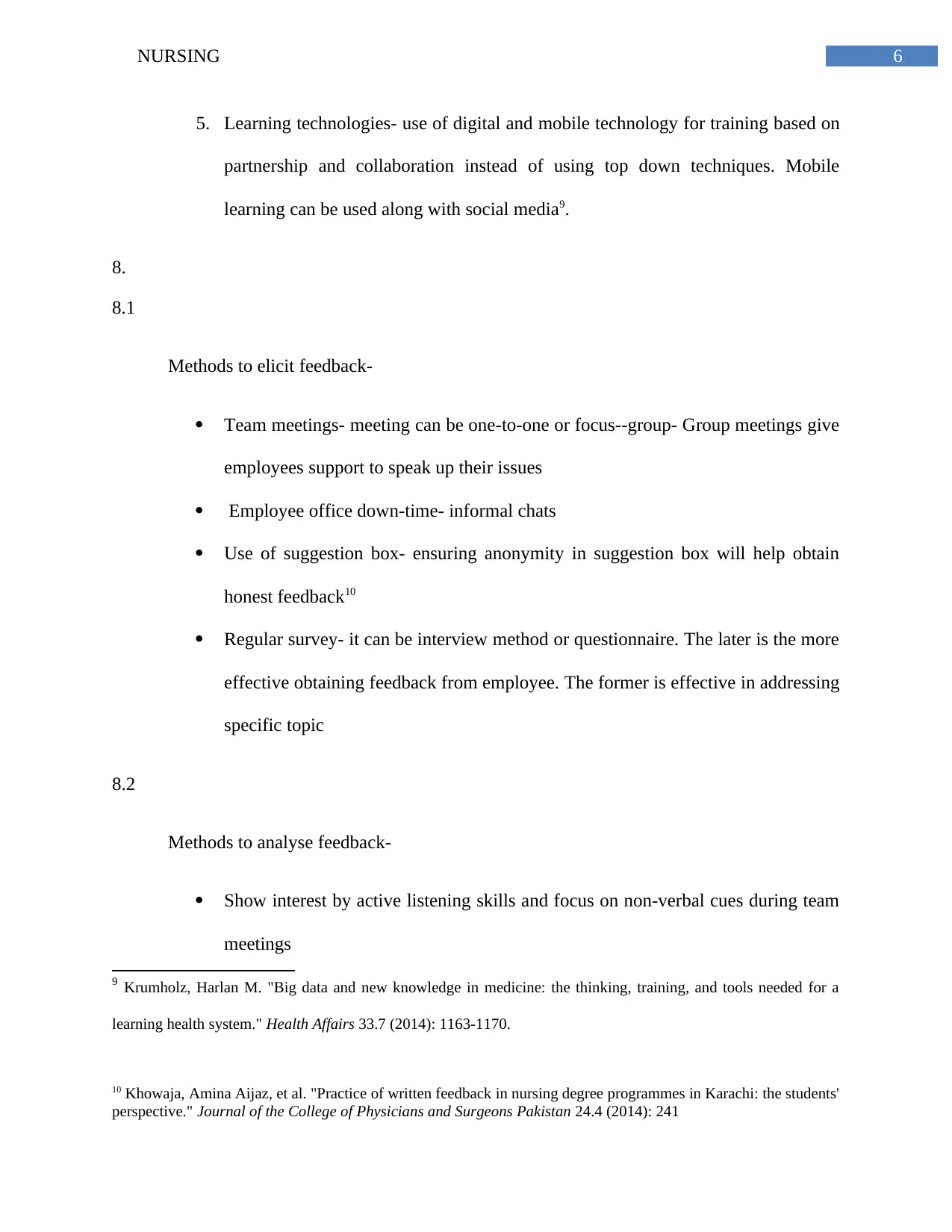
6NURSING
5. Learning technologies- use of digital and mobile technology for training based on
partnership and collaboration instead of using top down techniques. Mobile
learning can be used along with social media9.
8.
8.1
Methods to elicit feedback-
Team meetings- meeting can be one-to-one or focus--group- Group meetings give
employees support to speak up their issues
Employee office down-time- informal chats
Use of suggestion box- ensuring anonymity in suggestion box will help obtain
honest feedback10
Regular survey- it can be interview method or questionnaire. The later is the more
effective obtaining feedback from employee. The former is effective in addressing
specific topic
8.2
Methods to analyse feedback-
Show interest by active listening skills and focus on non-verbal cues during team
meetings
9 Krumholz, Harlan M. "Big data and new knowledge in medicine: the thinking, training, and tools needed for a
learning health system." Health Affairs 33.7 (2014): 1163-1170.
10 Khowaja, Amina Aijaz, et al. "Practice of written feedback in nursing degree programmes in Karachi: the students'
perspective." Journal of the College of Physicians and Surgeons Pakistan 24.4 (2014): 241
5. Learning technologies- use of digital and mobile technology for training based on
partnership and collaboration instead of using top down techniques. Mobile
learning can be used along with social media9.
8.
8.1
Methods to elicit feedback-
Team meetings- meeting can be one-to-one or focus--group- Group meetings give
employees support to speak up their issues
Employee office down-time- informal chats
Use of suggestion box- ensuring anonymity in suggestion box will help obtain
honest feedback10
Regular survey- it can be interview method or questionnaire. The later is the more
effective obtaining feedback from employee. The former is effective in addressing
specific topic
8.2
Methods to analyse feedback-
Show interest by active listening skills and focus on non-verbal cues during team
meetings
9 Krumholz, Harlan M. "Big data and new knowledge in medicine: the thinking, training, and tools needed for a
learning health system." Health Affairs 33.7 (2014): 1163-1170.
10 Khowaja, Amina Aijaz, et al. "Practice of written feedback in nursing degree programmes in Karachi: the students'
perspective." Journal of the College of Physicians and Surgeons Pakistan 24.4 (2014): 241
Paraphrase This Document
Need a fresh take? Get an instant paraphrase of this document with our AI Paraphraser
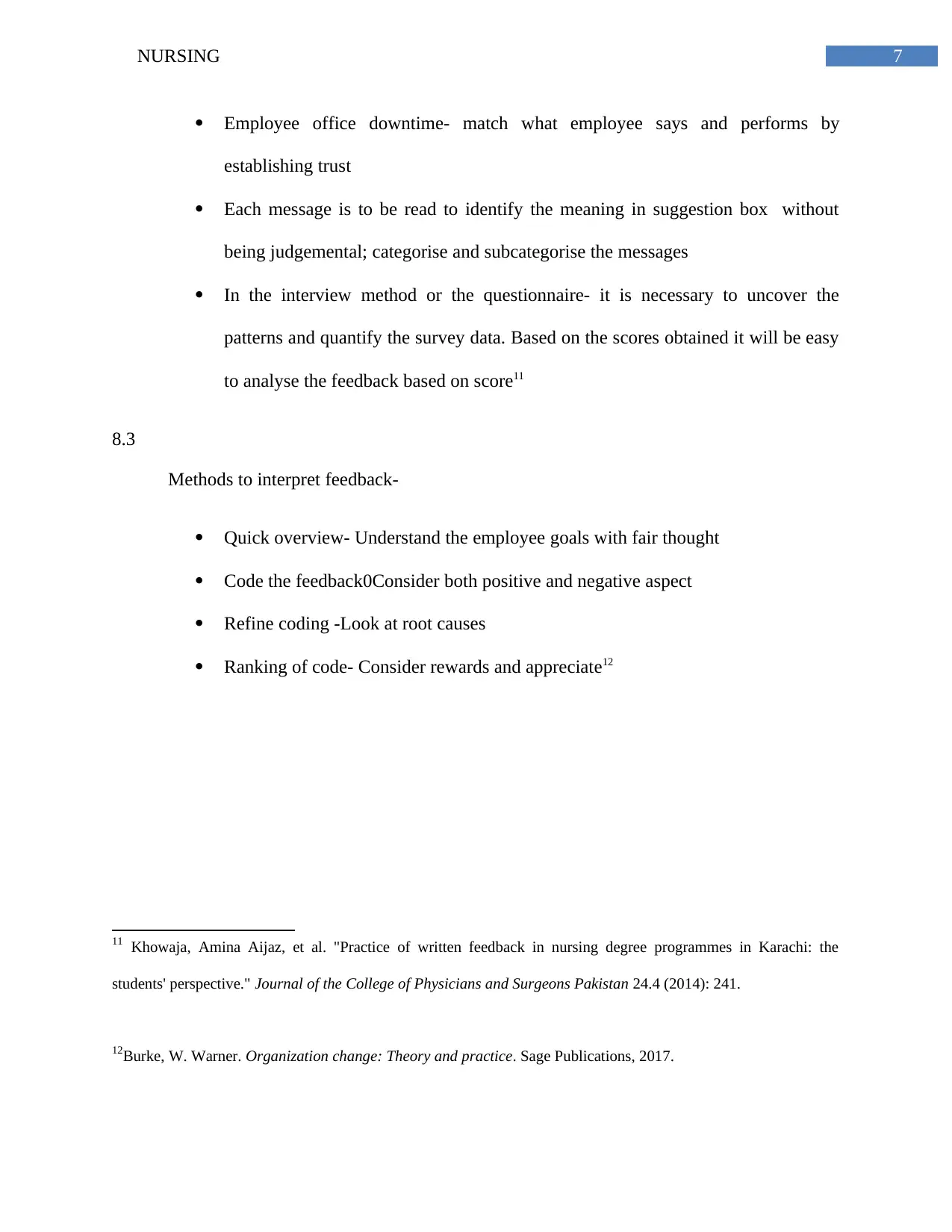
7NURSING
Employee office downtime- match what employee says and performs by
establishing trust
Each message is to be read to identify the meaning in suggestion box without
being judgemental; categorise and subcategorise the messages
In the interview method or the questionnaire- it is necessary to uncover the
patterns and quantify the survey data. Based on the scores obtained it will be easy
to analyse the feedback based on score11
8.3
Methods to interpret feedback-
Quick overview- Understand the employee goals with fair thought
Code the feedback0Consider both positive and negative aspect
Refine coding -Look at root causes
Ranking of code- Consider rewards and appreciate12
11 Khowaja, Amina Aijaz, et al. "Practice of written feedback in nursing degree programmes in Karachi: the
students' perspective." Journal of the College of Physicians and Surgeons Pakistan 24.4 (2014): 241.
12Burke, W. Warner. Organization change: Theory and practice. Sage Publications, 2017.
Employee office downtime- match what employee says and performs by
establishing trust
Each message is to be read to identify the meaning in suggestion box without
being judgemental; categorise and subcategorise the messages
In the interview method or the questionnaire- it is necessary to uncover the
patterns and quantify the survey data. Based on the scores obtained it will be easy
to analyse the feedback based on score11
8.3
Methods to interpret feedback-
Quick overview- Understand the employee goals with fair thought
Code the feedback0Consider both positive and negative aspect
Refine coding -Look at root causes
Ranking of code- Consider rewards and appreciate12
11 Khowaja, Amina Aijaz, et al. "Practice of written feedback in nursing degree programmes in Karachi: the
students' perspective." Journal of the College of Physicians and Surgeons Pakistan 24.4 (2014): 241.
12Burke, W. Warner. Organization change: Theory and practice. Sage Publications, 2017.
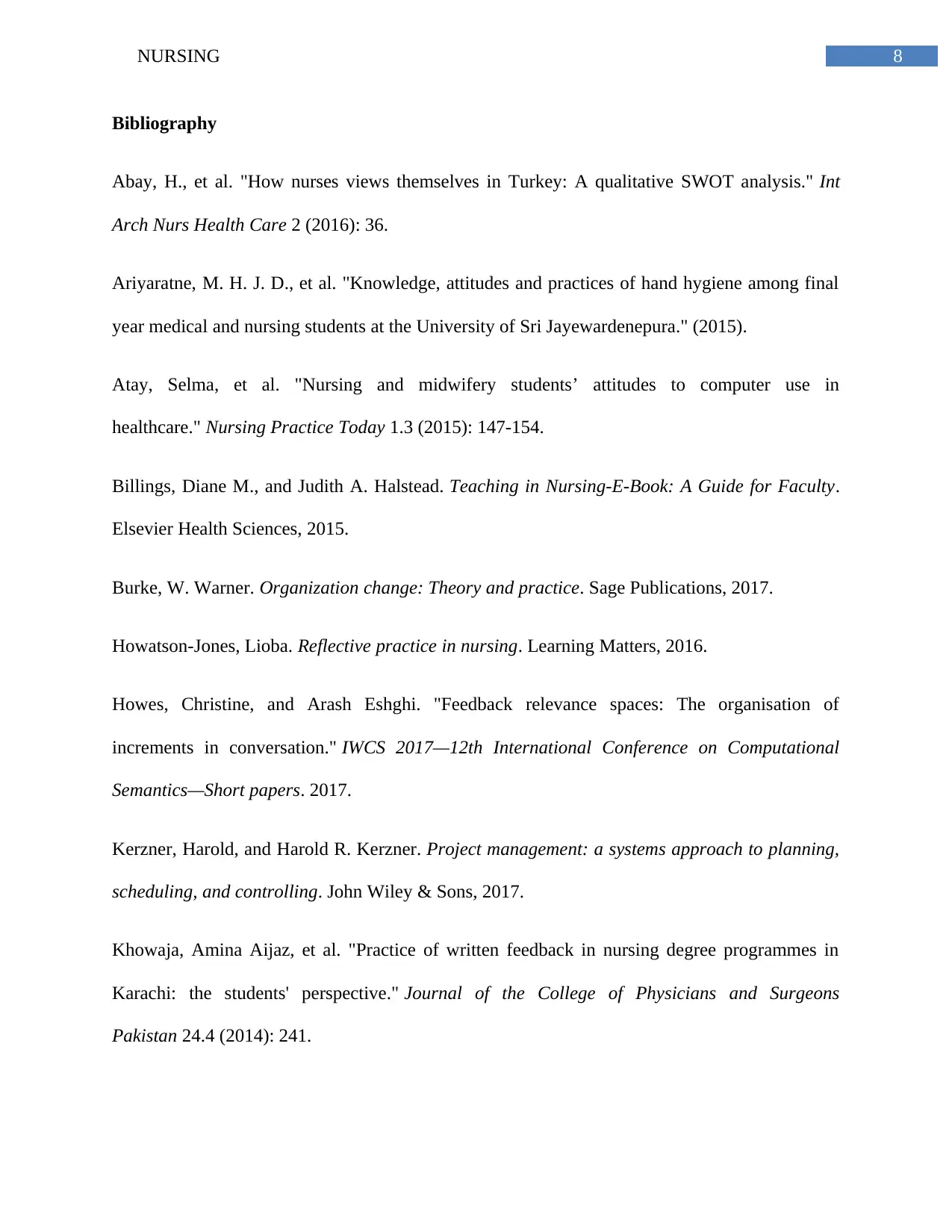
8NURSING
Bibliography
Abay, H., et al. "How nurses views themselves in Turkey: A qualitative SWOT analysis." Int
Arch Nurs Health Care 2 (2016): 36.
Ariyaratne, M. H. J. D., et al. "Knowledge, attitudes and practices of hand hygiene among final
year medical and nursing students at the University of Sri Jayewardenepura." (2015).
Atay, Selma, et al. "Nursing and midwifery students’ attitudes to computer use in
healthcare." Nursing Practice Today 1.3 (2015): 147-154.
Billings, Diane M., and Judith A. Halstead. Teaching in Nursing-E-Book: A Guide for Faculty.
Elsevier Health Sciences, 2015.
Burke, W. Warner. Organization change: Theory and practice. Sage Publications, 2017.
Howatson-Jones, Lioba. Reflective practice in nursing. Learning Matters, 2016.
Howes, Christine, and Arash Eshghi. "Feedback relevance spaces: The organisation of
increments in conversation." IWCS 2017—12th International Conference on Computational
Semantics—Short papers. 2017.
Kerzner, Harold, and Harold R. Kerzner. Project management: a systems approach to planning,
scheduling, and controlling. John Wiley & Sons, 2017.
Khowaja, Amina Aijaz, et al. "Practice of written feedback in nursing degree programmes in
Karachi: the students' perspective." Journal of the College of Physicians and Surgeons
Pakistan 24.4 (2014): 241.
Bibliography
Abay, H., et al. "How nurses views themselves in Turkey: A qualitative SWOT analysis." Int
Arch Nurs Health Care 2 (2016): 36.
Ariyaratne, M. H. J. D., et al. "Knowledge, attitudes and practices of hand hygiene among final
year medical and nursing students at the University of Sri Jayewardenepura." (2015).
Atay, Selma, et al. "Nursing and midwifery students’ attitudes to computer use in
healthcare." Nursing Practice Today 1.3 (2015): 147-154.
Billings, Diane M., and Judith A. Halstead. Teaching in Nursing-E-Book: A Guide for Faculty.
Elsevier Health Sciences, 2015.
Burke, W. Warner. Organization change: Theory and practice. Sage Publications, 2017.
Howatson-Jones, Lioba. Reflective practice in nursing. Learning Matters, 2016.
Howes, Christine, and Arash Eshghi. "Feedback relevance spaces: The organisation of
increments in conversation." IWCS 2017—12th International Conference on Computational
Semantics—Short papers. 2017.
Kerzner, Harold, and Harold R. Kerzner. Project management: a systems approach to planning,
scheduling, and controlling. John Wiley & Sons, 2017.
Khowaja, Amina Aijaz, et al. "Practice of written feedback in nursing degree programmes in
Karachi: the students' perspective." Journal of the College of Physicians and Surgeons
Pakistan 24.4 (2014): 241.
⊘ This is a preview!⊘
Do you want full access?
Subscribe today to unlock all pages.

Trusted by 1+ million students worldwide
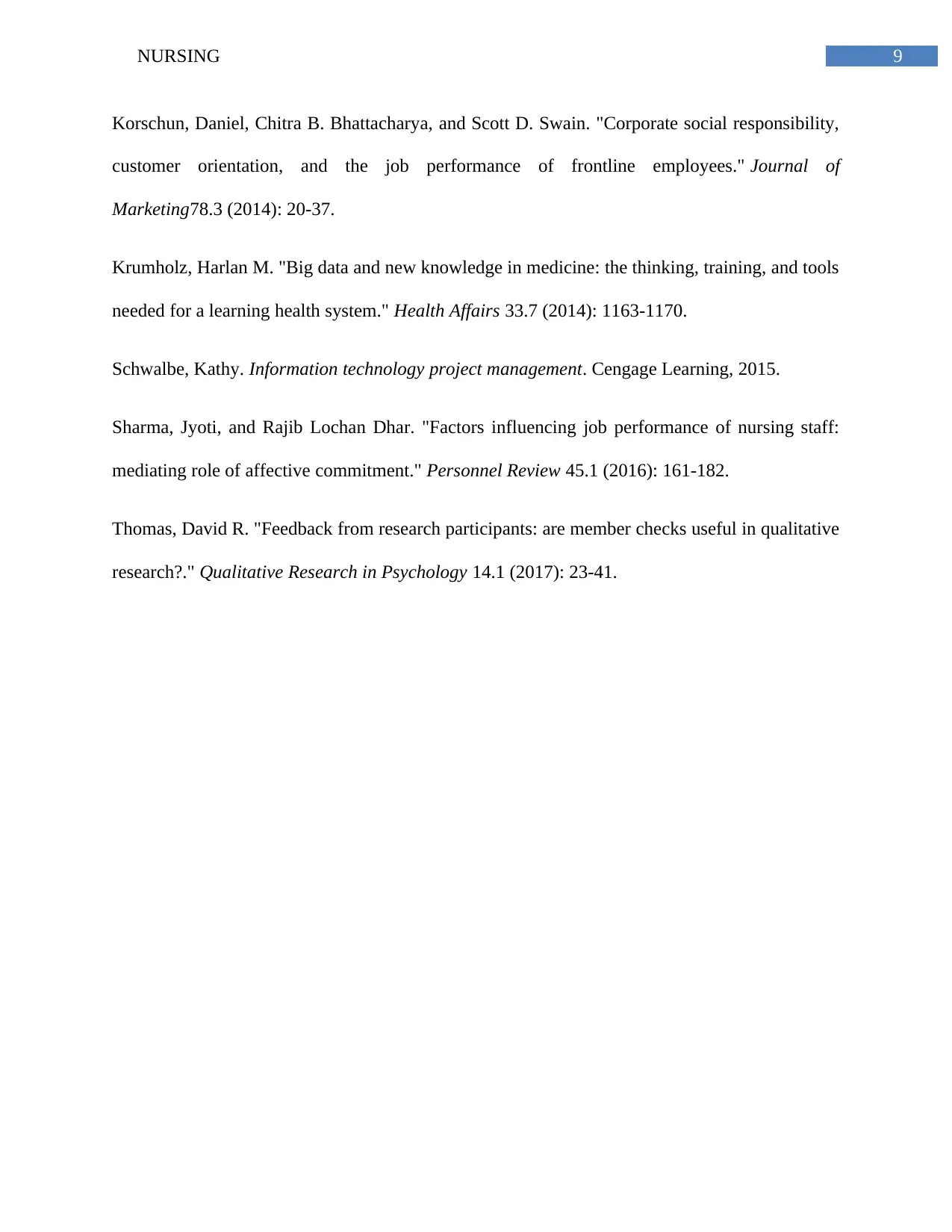
9NURSING
Korschun, Daniel, Chitra B. Bhattacharya, and Scott D. Swain. "Corporate social responsibility,
customer orientation, and the job performance of frontline employees." Journal of
Marketing78.3 (2014): 20-37.
Krumholz, Harlan M. "Big data and new knowledge in medicine: the thinking, training, and tools
needed for a learning health system." Health Affairs 33.7 (2014): 1163-1170.
Schwalbe, Kathy. Information technology project management. Cengage Learning, 2015.
Sharma, Jyoti, and Rajib Lochan Dhar. "Factors influencing job performance of nursing staff:
mediating role of affective commitment." Personnel Review 45.1 (2016): 161-182.
Thomas, David R. "Feedback from research participants: are member checks useful in qualitative
research?." Qualitative Research in Psychology 14.1 (2017): 23-41.
Korschun, Daniel, Chitra B. Bhattacharya, and Scott D. Swain. "Corporate social responsibility,
customer orientation, and the job performance of frontline employees." Journal of
Marketing78.3 (2014): 20-37.
Krumholz, Harlan M. "Big data and new knowledge in medicine: the thinking, training, and tools
needed for a learning health system." Health Affairs 33.7 (2014): 1163-1170.
Schwalbe, Kathy. Information technology project management. Cengage Learning, 2015.
Sharma, Jyoti, and Rajib Lochan Dhar. "Factors influencing job performance of nursing staff:
mediating role of affective commitment." Personnel Review 45.1 (2016): 161-182.
Thomas, David R. "Feedback from research participants: are member checks useful in qualitative
research?." Qualitative Research in Psychology 14.1 (2017): 23-41.
1 out of 10
Related Documents
Your All-in-One AI-Powered Toolkit for Academic Success.
+13062052269
info@desklib.com
Available 24*7 on WhatsApp / Email
![[object Object]](/_next/static/media/star-bottom.7253800d.svg)
Unlock your academic potential
Copyright © 2020–2025 A2Z Services. All Rights Reserved. Developed and managed by ZUCOL.





